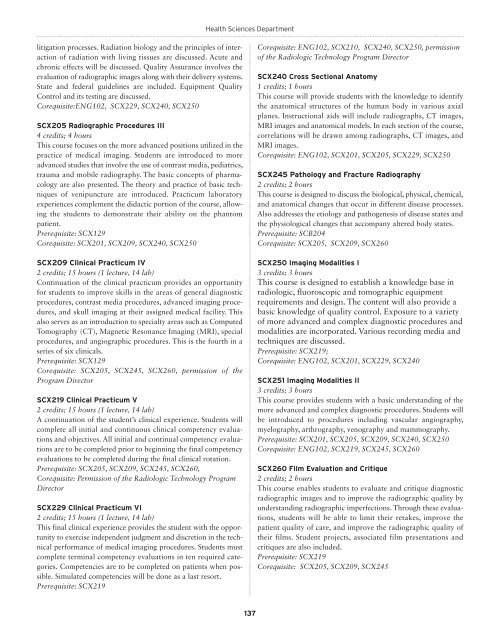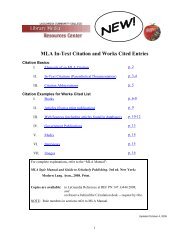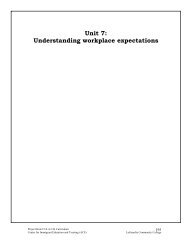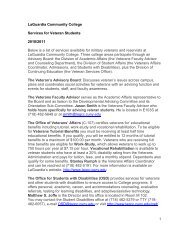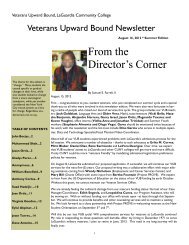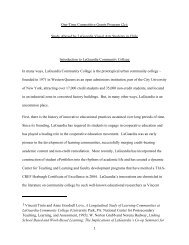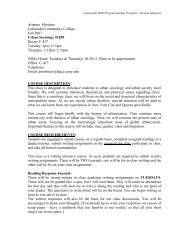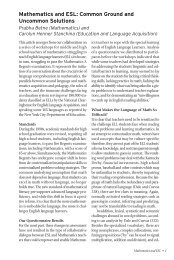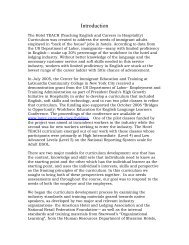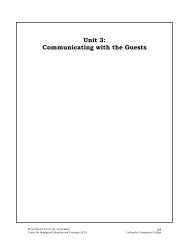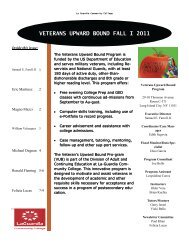COURSE INDEX - LaGuardia Community College
COURSE INDEX - LaGuardia Community College
COURSE INDEX - LaGuardia Community College
You also want an ePaper? Increase the reach of your titles
YUMPU automatically turns print PDFs into web optimized ePapers that Google loves.
Health Sciences Department<br />
litigation processes. Radiation biology and the principles of interaction<br />
of radiation with living tissues are discussed. Acute and<br />
chronic effects will be discussed. Quality Assurance involves the<br />
evaluation of radiographic images along with their delivery systems.<br />
State and federal guidelines are included. Equipment Quality<br />
Control and its testing are discussed.<br />
Corequisite:ENG102, SCX229, SCX240, SCX250<br />
SCX205 Radiographic Procedures III<br />
4 credits; 4 hours<br />
This course focuses on the more advanced positions utilized in the<br />
practice of medical imaging. Students are introduced to more<br />
advanced studies that involve the use of contrast media, pediatrics,<br />
trauma and mobile radiography. The basic concepts of pharmacology<br />
are also presented. The theory and practice of basic techniques<br />
of venipuncture are introduced. Practicum laboratory<br />
experiences complement the didactic portion of the course, allowing<br />
the students to demonstrate their ability on the phantom<br />
patient.<br />
Prerequisite: SCX129<br />
Corequisite: SCX201, SCX209, SCX240, SCX250<br />
SCX209 Clinical Practicum IV<br />
2 credits; 15 hours (1 lecture, 14 lab)<br />
Continuation of the clinical practicum provides an opportunity<br />
for students to improve skills in the areas of general diagnostic<br />
procedures, contrast media procedures, advanced imaging procedures,<br />
and skull imaging at their assigned medical facility. This<br />
also serves as an introduction to specialty areas such as Computed<br />
Tomography (CT), Magnetic Resonance Imaging (MRI), special<br />
procedures, and angiographic procedures. This is the fourth in a<br />
series of six clinicals.<br />
Prerequisite: SCX129<br />
Corequisite: SCX205, SCX245, SCX260, permission of the<br />
Program Director<br />
SCX219 Clinical Practicum V<br />
2 credits; 15 hours (1 lecture, 14 lab)<br />
A continuation of the student’s clinical experience. Students will<br />
complete all initial and continuous clinical competency evaluations<br />
and objectives. All initial and continual competency evaluations<br />
are to be completed prior to beginning the final competency<br />
evaluations to be completed during the final clinical rotation.<br />
Prerequisite: SCX205, SCX209, SCX245, SCX260,<br />
Corequisite: Permission of the Radiologic Technology Program<br />
Director<br />
SCX229 Clinical Practicum VI<br />
2 credits; 15 hours (1 lecture, 14 lab)<br />
This final clinical experience provides the student with the opportunity<br />
to exercise independent judgment and discretion in the technical<br />
performance of medical imaging procedures. Students must<br />
complete terminal competency evaluations in ten required categories.<br />
Competencies are to be completed on patients when possible.<br />
Simulated competencies will be done as a last resort.<br />
Prerequisite: SCX219<br />
Corequisite: ENG102, SCX210, SCX240, SCX250, permission<br />
of the Radiologic Technology Program Director<br />
SCX240 Cross Sectional Anatomy<br />
1 credits; 1 hours<br />
This course will provide students with the knowledge to identify<br />
the anatomical structures of the human body in various axial<br />
planes. Instructional aids will include radiographs, CT images,<br />
MRI images and anatomical models. In each section of the course,<br />
correlations will be drawn among radiographs, CT images, and<br />
MRI images.<br />
Corequisite: ENG102, SCX201, SCX205, SCX229, SCX250<br />
SCX245 Pathology and Fracture Radiography<br />
2 credits; 2 hours<br />
This course is designed to discuss the biological, physical, chemical,<br />
and anatomical changes that occur in different disease processes.<br />
Also addresses the etiology and pathogenesis of disease states and<br />
the physiological changes that accompany altered body states.<br />
Prerequisite: SCB204<br />
Corequisite: SCX205, SCX209, SCX260<br />
SCX250 Imaging Modalities I<br />
3 credits; 3 hours<br />
This course is designed to establish a knowledge base in<br />
radiologic, fluoroscopic and tomographic equipment<br />
requirements and design. The content will also provide a<br />
basic knowledge of quality control. Exposure to a variety<br />
of more advanced and complex diagnostic procedures and<br />
modalities are incorporated. Various recording media and<br />
techniques are discussed.<br />
Prerequisite: SCX219;<br />
Corequisite: ENG102, SCX201, SCX229, SCX240<br />
SCX251 Imaging Modalities II<br />
3 credits; 3 hours<br />
This course provides students with a basic understanding of the<br />
more advanced and complex diagnostic procedures. Students will<br />
be introduced to procedures including vascular angiography,<br />
myelography, arthrography, venography and mammography.<br />
Prerequisite: SCX201, SCX205, SCX209, SCX240, SCX250<br />
Corequisite: ENG102, SCX219, SCX245, SCX260<br />
SCX260 Film Evaluation and Critique<br />
2 credits; 2 hours<br />
This course enables students to evaluate and critique diagnostic<br />
radiographic images and to improve the radiographic quality by<br />
understanding radiographic imperfections. Through these evaluations,<br />
students will be able to limit their retakes, improve the<br />
patient quality of care, and improve the radiographic quality of<br />
their films. Student projects, associated film presentations and<br />
critiques are also included.<br />
Prerequisite: SCX219<br />
Corequisite: SCX205, SCX209, SCX245<br />
137


